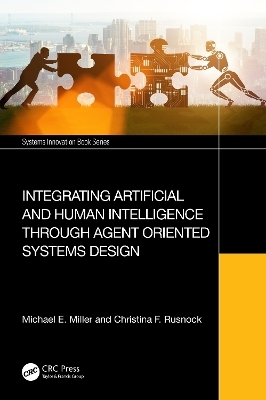
Integrating Artificial and Human Intelligence through Agent Oriented Systems Design
CRC Press (Verlag)
978-1-032-54657-5 (ISBN)
This book departs from the assumption that Artificial Intelligence (AI) systems will provide a maximum advantage by replacing human cognitive processing. Instead, this book subscribes to the assumption that AI systems will provide a maximal advantage when the system is specifically designed to augment human intelligence. It provides methods for designing effective systems that include one or more humans and one or more AI entities and uses the approach that assumes automation does not replace human activity but fundamentally changes the structure of human work when AI is added to existing systems.
Integrating Artificial and Human Intelligence through Agent Oriented Systems Design discusses the potential impact of AI on human work and life and explores why teamwork is necessary today for complex work environments. The book explains the processes and methods humans employ to effectively team with one another and presents the elements of artificial agents that permit them to function as team members in joint human and artificial teams. It discusses design goals and illustrates how the methods that have been used to model the complex interactions among human and artificial agents can be expanded to enable the design of interaction between them to make possible the attainment of the shared goals. Model-Based Systems Engineering (MBSE) tools that provide logical designs of human–agent teams, the AI within these teams, training to be deployed for human and artificial agent team members, and the interfaces between human and artificial agent team members are all covered. MBSE files containing profiles and examples for building MBSE models used in the design approach are featured on the author’s website (https://lodesterresci.com/hat).
This book is an ideal read for students, professors, engineers, and project managers associated with designing and developing AI systems or systems that seek to incorporate AI.
Michael E. Miller is a Professor of Systems Engineering at the Air Force Institute of Technology where he teaches courses in human factors, human performance modeling, and human systems integration, including a course in Human-Agent Teaming. Mike’s recent research has focused on human representations in systems engineering models, including a SysML extension for developing descriptive models of systems which include small teams of humans and agents working to seek common goals. Mike has contributed to more than 100 issued U.S. patents on digital imaging and display systems, 50 peer‐reviewed journal articles, and numerous conference proceedings. Lt Col Christina F. Rusnock is an Adjunct Associate Professor of the Department of Systems Engineering and Management at the Air Force Institute of Technology, Wright Patterson AFB, OH. Dr. Rusnock earned her Ph.D. in Industrial Engineering, Human Factors/Ergonomics Specialization, from the University of Central Florida, and an MS in Research and Development Management from the Air Force Institute of Technology. Her research interests include human performance modeling, mental workload, trust in automation, and situation awareness, with a focus on applications in human-machine teaming for autonomous systems. She has contributed to over 50 books, journal articles, and conference proceedings.
1. Introducing Human–AI Teaming. 2. Defining Your System. 3. Goals and Responsibilities. 4. What is Teaming?. 5. Automation and System Redesign. 6. AI Methods and Agent Architectures. 7. Allocation. 8. Human–AI Agent Team Architectural Patterns. 9. Decision-Making and Decision Support Systems. 10. Designing for Exceptions. 11. System Verification through Coactive Design. 12. Human Capabilities and Capacity. 13. Completing System Specifications in the AOSM. 14. Future of Agent-Oriented Systems Modeling. Appendix A: AOSM Profile, Language Extension
| Erscheinungsdatum | 11.07.2024 |
|---|---|
| Reihe/Serie | Systems Innovation Book Series |
| Zusatzinfo | 9 Tables, black and white; 75 Line drawings, black and white; 75 Illustrations, black and white |
| Verlagsort | London |
| Sprache | englisch |
| Maße | 156 x 234 mm |
| Gewicht | 760 g |
| Themenwelt | Informatik ► Theorie / Studium ► Künstliche Intelligenz / Robotik |
| Naturwissenschaften ► Biologie ► Humanbiologie | |
| Naturwissenschaften ► Biologie ► Zoologie | |
| Technik ► Elektrotechnik / Energietechnik | |
| Technik ► Umwelttechnik / Biotechnologie | |
| ISBN-10 | 1-032-54657-3 / 1032546573 |
| ISBN-13 | 978-1-032-54657-5 / 9781032546575 |
| Zustand | Neuware |
| Informationen gemäß Produktsicherheitsverordnung (GPSR) | |
| Haben Sie eine Frage zum Produkt? |
aus dem Bereich


